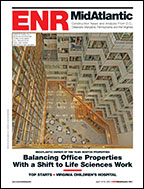

Construction workers on May 3 engaged in a carefully choreographed dance of machine and muscle to erect a 2,000-lb net sculpture 365 ft over Boston's Rose Kennedy Greenway, a 1.5-mile stretch of park created after the city's Big Dig.
Designed by artist Janet Echelman, the giant aerial sculpture, which resembles a jellyfish and stretches out 600 ft, hangs from 10 cables attached in four spots to three nearby high-rise buildings. After months of planning, a crew of about 30 skilled tradespeople working for general contractor Shawmut Design and Construction and rigging designer Marr Cos to hoist the netting in less than nine hours using six mobile telescopic cranes and a 135-ft-tall boom lift.
"In a lot of ways, it was as complex as building one of these larger buildings," says Micah O'Neil, senior project manager at Shawmut. "It's exciting to be involved in a piece of art in Boston that's pretty cutting-edge."
The delicate-looking sculpture is tougher than it appears. An inner sculptural net contains 1/8-in.- to ¼-in.-dia twine that is dyed in six different colors and tied into more than 542,000 knots. It is lashed to spliced structural cables that range in lengths between 10 ft and 270 ft and thicknesses of ½ in. to 1-3/8 in. The cable network is constructed of a braided and prestressed ultra-high-molecular-weight polyethylene that is eight times stronger than steel strand, according to Arup, the project's lead engineer. The structure supports 105-mile-per-hour winds while imposing tension loads of up to 70,000 lb on the buildings.
To confirm that adequate structural reserves would handle the extra loading, Arup employed a custom-made software program to model the sculpture. "The software allows us to analyze the sculpture and the shape it will take under these very high wind pressures," says Patrick McCaffrey, structural engineering practice group leader in Arup's Boston office. The net "becomes more aerodynamic as the wind blows," adds Clayton Binkley, the Seattle-based Arup structural engineer who wrote the software code. At night, lights wired to real-time load cells change colors as the wind tugs on the net.
Attached at heights of 60 ft to 365 ft and ratcheted in place using hoists and come-alongs, the net taps into the columns and beams of the existing structures. "Every connection point is different," O'Neil says. "The nature of this material is going to stretch and sag, so we'll have to go back in a month or so and adjust." The exhibit, which cost the Rose Kennedy Greenway Conservancy about $1 million to install, is scheduled to come down in October.



Post a comment to this article
Report Abusive Comment